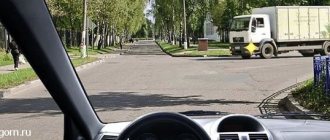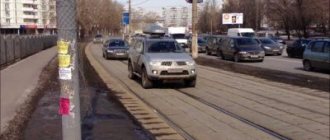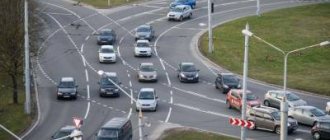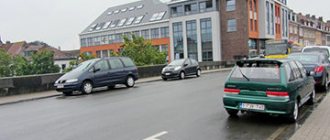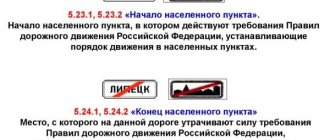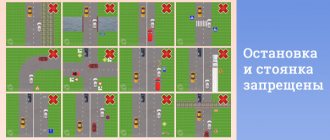Rules for driving through a T-shaped intersection according to traffic rules
Traffic rules clearly regulate the behavior of drivers when passing through a T-shaped intersection. In many ways, the scenario of action depends on the type of road crossing. There are intersections:
- adjustable;
- unregulated.
Example of a T-junction
The first are characterized by the presence of a working traffic light or traffic controller. In the second case, there is no traffic light at the intersection, it is in a faulty condition and the traffic controller is not working.
Traditionally, it is the second type that causes certain difficulties for inexperienced drivers.
Adjustable (with traffic light)
When driving through this type of road intersection, you need to pay attention not only to signs and markings, but also to traffic lights. It is he who usually shows what the driver needs to do at a particular moment in time
It is he who usually shows what the driver needs to do at a particular moment in time.
Traffic light signals have the following meaning:
- red - movement is prohibited;
- yellow - a transition signal, indicating the need to prepare for the start of the journey or complete the started maneuver;
- green allows movement.
There are no particular difficulties when following a signalized T-junction
However, it is necessary to pay attention to the presence of an additional traffic light arrow. It is installed in order to speed up and simplify the procedure for moving along one of the lanes
It is important to understand that when moving along the additional arrow, the color of the second indicator matters. If it is red, then the driver needs to be careful and give way to other vehicles.
Driving through T-shaped unregulated intersections
Difficulties may arise when driving through a T-shaped uncontrolled intersection.
In this case, traffic light signals will not help the driver to navigate.
That is why it is necessary to rely on the instructions of signs and markings.
Priority signs will indicate to drivers the need to let other vehicles pass or move first
If there are unequal roads at a T-shaped intersection, then it is important to promptly determine who has the main
A priority road may be designated:
- "Main Road" sign;
- the nature of the road surface.
In the second case, when crossing an asphalt road with gravel, the first is considered priority.
When crossing equivalent roads, there is an obstacle on the right
Let's consider how to correctly navigate t-shaped intersections of equivalent roads. If there are equivalent roads, drivers should use the “interference on the right” rule. According to it, the driver is obliged to give way to those vehicles that are on his right.
In addition, when performing a maneuver, you should pay attention to the presence of one-way traffic within the intersection. When a car is moving towards an intersection where the perpendicular road is one-way, the driver should take the required lane in advance
It is strictly forbidden to turn in the direction opposite to one-way traffic, as this will create an emergency situation and may cause an accident.
T-junction parking.
Stopping at a T-junction
In such cases, the Rules allow stopping and parking on the right side of the road - on the edge of the roadway.
The driver must clearly understand that even if there is a shoulder and the opportunity to stop and park on it, he is prohibited from using the roadway for these purposes. Such tactics would be a gross violation of traffic rules, and most often drivers commit it when driving outside a populated area. Thus, they not only interfere with the movement of other vehicles, but also contribute to the creation of an emergency situation in high-speed traffic.
The rules provide for stopping and parking not only on the right side of the road. In two cases it is allowed to park on its left side. But both of these options are directly related to sections of roads in a populated area.
1. A two-lane road (one lane for each direction), with no tram tracks in the middle. Stopping and parking on the left side of such roads, at first glance, looks unsafe. After all, leaving such a parking lot will be done from the oncoming traffic lane.
However, in a populated area - under the current speed limit - this danger does not seem so serious. But the need to find a parking space, on the contrary, looks like a fairly pressing problem. The requirement for no tram tracks in the middle of the road becomes quite understandable.
It’s just that in this case, leaving the parking lot on the left side of a very wide road will no longer be safe. 2. One-way road.
The right to stop on the left side of a one-way road should not cause skepticism or rejection, because traffic along the entire width of the roadway is carried out in one direction. Regarding the situation outside
How far from the intersection can you park?
Signs 3-27-3.30 are only valid on one side of the road. Sign 5.27 “sign coverage area” – for the entire road. Of course, everyone remembers what a “give way” sign looks like, but it’s unlikely that many of you remember how many meters there should be from the sign to the intersection.
Since stopping is also allowed on the left oncoming side of the road, a situation arises that it would seem possible to stop on the left side after passing a pedestrian crossing. This interpretation is not correct. “Before the crosswalk” should be interpreted relative to the intended direction of travel in the lane, not the actual direction of the vehicle. This is both logical and safe.
In order to better understand how to stop correctly at an intersection, I propose to consider several diagrams.
It is prohibited to drive without stopping in front of the stop line, and if there is none, in front of the edge of the roadway being crossed. The driver must give way to vehicles moving along the intersection, and if there is a sign 8.13 - on the main road.
The angle of entry is close to 90 degrees - this, in fact, is a T-shaped intersection. In the case of a merging angle that is sharper or dumber than 90 degrees, an intersection identical to the letter “U” is obtained.
The exception is cases when stopping a car with traffic violations is caused by a malfunction of the car or poor health of the driver or his passengers.
When driving is carried out when a green arrow is indicated, activated together with the main red traffic light indicator, there is a need for increased vigilance, because it is imperative to give way to cars (and other vehicles) that are moving from another direction - this is exactly how this case is prescribed in the rules.
You cannot stop at a pedestrian crossing or closer than 5 m in front of a pedestrian crossing, but you can stand immediately behind it.
In the case where a car is parked in such an area completely on the side of the road and in no way affects the trajectory of traffic on its roadway, this is not a violation of the Rules.
Stopping in modern conditions of heavy traffic and high speeds is a very responsible matter. It is necessary to stop not anyhow, but carefully choosing a safe place, otherwise the consequences of even a seemingly harmless short stop for boarding and disembarking passengers can become tragic. This requirement is due to the need to ensure good visibility of the approaching train at the crossing.
Driving through a T-junction of equivalent roads
If traffic lights (adjustable) or priority signs (unequal) are installed at the intersection, then the order of passage does not raise questions among drivers.
However, if there is a T- junction on the road without signs, i.e. equivalent , then misunderstandings often arise.
Consider the following figure:
Drivers must be guided by paragraphs 13.11 and 13.12 of the traffic rules:
13.11. At the intersection of equivalent roads, with the exception of the case provided for in paragraph 13.11 1 of the Rules, the driver of a trackless vehicle is obliged to give way to vehicles approaching from the right.
13.12. When turning left or making a U-turn, the driver of a trackless vehicle is obliged to give way to vehicles moving on an equivalent road from the opposite direction straight or to the right.
Those. The so-called “interference from the right” rule applies.
For example, the green and orange cars are going straight, and the white car is turning right. In this case, the orange car must give way to the white one, because he is approaching from the right.
Look at the drawing again. It is no coincidence that one of the roads is depicted as four-lane, and the second as two-lane. If you come across such an intersection, you will probably notice that many drivers consider the wider road to be the main one, i.e. they believe that cars traveling straight have priority . Actually this is not true.
However, this fact must be taken into account. Those. In the place of a white car, which has priority over an orange one, you should make sure that the orange one gives way. In the event of an accident, the driver of the orange car will be at fault, but it is in your interests to avoid a collision.

